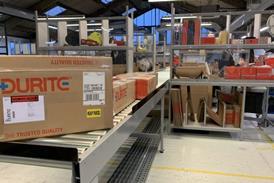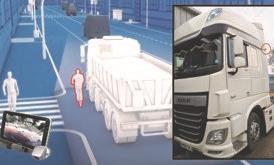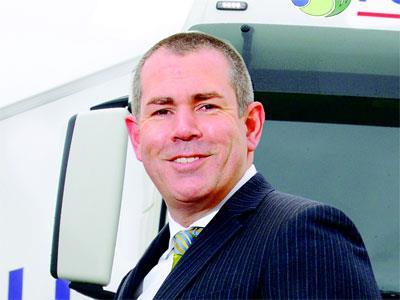
Fowler Welch MD Nick Hay has strong views on fleet replacement cycles and the switch to Euro-6 as he explains to Steve Hobson
Fowler Welch runs a fleet of 400 units and 800 trailers from 10 sites around the UK. Best known as a chilled operator, it dropped the ‘Coolchain’ from its public name in 2011 as it expanded into ambient distribution and today around 30% of its revenues come from the ambient side of the business.
MD Nick Hay cites improving fuel economy from the fleet as one of the key drivers in improving Fowler Welch’s bottom line in the past year, and he is keen to maintain that performance. “We have made massive progress on mpg,” he says. “It has improved 6% and when you are spending over £20m on fuel that is a big number.”
Hay knows that running a successful logistics business in the current climate means never taking your eye off the cost control ball, as the difference between profit and loss is so slender. “You have to be good at operating in all the key areas – managing people, making sure the truck is full in both directions, and managing mpg, accident damage and purchasing – it is about all those things,” says Hay. “You have to be willing to invest. We have invested a huge amount in telemetry across our fleet and managing the output of that telemetry, and we are now seeing a huge improvement.”
He also knows there is no point investing in telematics to monitor driver behaviour if the management processes are not in place to use the data effectively. “We have 600 drivers and have recruited three driver development managers across the business in the last 12 months,” he says. “Their job to take the output of the telemetry and help the driver trainers use that information to do the right things. There is also a huge amount going on with tyres, trailer designs etc. And we have recruited three fleet managers in last 12 months, all with the aim of reducing our cost of operation. The safest thing to do is not make that investment but that is short term thinking.”
Positive loop
The aim has to be to get into a positive loop, with high service levels driving up rates, and so increasing profits which can then be reinvested in the business to drive down costs. “You need to make a profit to make those kinds of investments. Once we have improved to 9mpg our customer will be demanding 10 – and I will be demanding 10 of our business,” says Hay. “So you have to continually invest and without profit you can’t afford that investment. Many smaller operators get to the stage that their fleet is so old the cost of reinvesting is prohibitive. That is when they end up pulling the plug.”
That is why Hay has no intention of changing Fowler Welch’s fleet replacement cycle just because of the transition from Euro-5 to Euro-6 at the end of 2013. “Some people think they are being clever by being a late entrant to Euro-6 – ‘we are going to maximise Euro-5 because it’s cheaper’,” he argues. “But what is that doing to your investment cycle on new trucks? It is creating a bubble at a later date. What will that do to the industry? Truck prices will go through the roof; everyone thinks the residual values on Euro-5 will be higher but it will catch up with you. All that will happen is lead times will shoot up and then shoot down, prices will shoot up and then plummet.
“All they are doing is looking short term for 12 months or two years but in that third year it will come and bite you. Time and time again you see distribution businesses play around with investment cycles on trucks, trailers, property, people – all you are doing is storing up a bubble. If that bubble coincides with a recession or the loss of a major customer you are in trouble. So you have to have a medium term approach and not try to be too smart.”
Short term
Short term thinking has bedevilled the transport industry, despite the long term nature of most of its assets.
“If we buy a property we need to think of operating it for 25 years,” says Hay. “If we buy a tractor and trailer for £120,000 – more if it’s doubledeck – we need to operate the tractor for at least three if not five years and the trailer for seven years to get that money back.
“How can you make decisions based on the next 12 months if all the investments are over three, five, seven or 25 years? That is where venture capitalists get it wrong. They invest in distribution businesses and start making decisions based on the next 12 months.”
Fowler Welch is proud of its modern fleet and has no intention of letting the average age rise just because of Euro-6 . “We replace our trucks after three years so the average age of our fleet is broadly between 18 months and two years, and we want to keep it that way,” says Hay “We took 56 MANs on in December last year, we have 20 Scanias coming in April and in December we will take on another 70-odd MANs and 70-odd Scanias. I will not run Euro-5 on just because I think I am getting a cheaper truck. All that will do is mess up our replacement cycle.
“In October we have four Euro-6s coming from each of five marques and we will run them in the fleet. It is really frustrating trying to get Euro-6s from the manufacturers – it’s like pulling teeth. Had we been able to get some on the fleet at the end of 2012 we would have bought all Euro-6 in 2013. I wanted to get Euro-6 trucks from four or five manufacturers in April but only two – Scania and Mercedes-Benz - have given me any Euro-6s which is disappointing.”
But will the truck builders learn the lessons of pre-recessionary 2008 and avoid a demand bubble? “There could be a lot of surplus Euro-5s,” warns Hay. “with the launch of Euro 5 we saw a lot of ghost orders that had pushed out lead times suddenly disappear, so this time I think one or two of the manufacturers will put in penalty clauses for ghost orders. ”
Hay is also among a number of operators questioning why truck makers have waited for Euro-6 to fit fuel saving devices.
“Why is it that they are now saying the mpg – despite the fact Euro-6 engines are supposed to be less efficient - will be higher?” he asks. “It is because they have waited until Euro-6 to make some fuel efficient modifications. They got it all ready, just waited til Euro-6. We offered to put Euro-6 in our fleet, give them full access to all the data and work with the manufacturers. All most of them say is they haven’t got one and don’t want to talk about it yet.”
Fleet buyers
Hay also has some strong words for truck manufacturers on what national fleet buyers are really looking for. “We were mainly a Volvo fleet but we have changed the mix now. We are too big to run just one marque. By the end of this year we will be a third Volvo, a third MAN and a third Scania,” he says. “We also tried Daf– the gap between the major manufacturers is now really small in terms of performance and driver acceptance, and the big challenge is service. Daf has some very strong dealers including my local Daf dealer Ford & Slater.
“But my challenge to manufacturers is ‘are you a national outfit that will go with me nationally or a local outfit?’ If they can’t answer that question then that is in itself a problem. That is where certainly MAN and Scania have gone with us – it is clear who we are dealing with while with Volvo and Daf it is less clear. Manufacturer or local dealer - let’s keep it simple.”
Hay has another bee in his bonnet – the way the DfT allocated the 1,800 10-year licences to run longer semi-trailers. “Why is it, as an operator with 800 trailers, I got an allocation of three?” he fumes. “We had the first three on the road on ambient - loads of licences have not been taken up and I can’t get them. I would have as many on the road as I could get. The rules were very unclear. We applied for the number we knew we could operate from day one. It was over-subscribed so they just made the allocations pro rata.”
There have been stories of operators trying to sell surplus licences, something they were not allowed to do.
“I had some approaches offering to sell licences,” confirms Hay. “I’ve still only got three.”
He goes on: “Why is the DfT waiting to force people to use or lose them? I’ve had three on the road for six months and I would happily have 20.”
Fowler Welch runs four chilled and 16 ambient doubledecks – “not enough” according to Hay – and is ordering more. Hay sums up the pros and cons of 15.65m singledecks and 13.6m doubledecks: “The longer singledeck is more flexible. The cost increase for the additional capacity [four more pallets than a 13.6m trailer] is more pro rata with the longer semi than a doubledeck - but you need a lot of volume for the doubledecks – 40 pallets plus. The scope for a longer semi carrying 30 pallets is far greater and it can be treated as ‘normal’ trailer.”

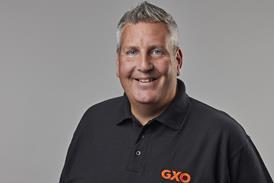
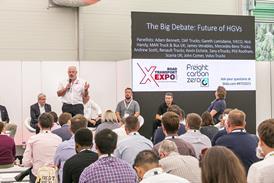
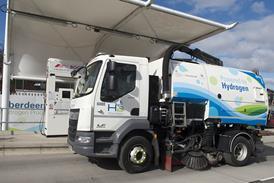


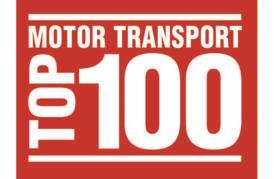
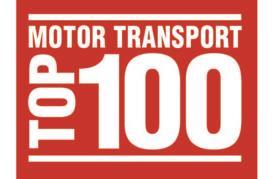
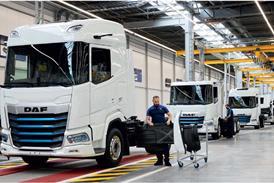
![Mercedes-Benz_eActros_600_(1)[1]](jpg/17820_mercedesbenz_eactros_600_11_978080.jpg)

